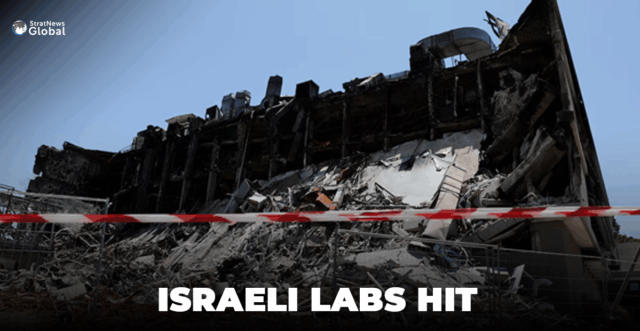Israeli researchers at the renowned Weizmann Institute of Science are scrambling to rescue their experiments after an Iranian missile destroyed a building housing dozens of advanced laboratories.
The missile struck the institute’s campus at Rehovot, on the southern periphery of Tel Aviv, in the early hours of Sunday, damaging multiple buildings and prompting researchers to clamber into the ruins to save samples even as fire raged.
No one was hurt as the campus was empty overnight, but one part of a building collapsed, while in the remaining part, the walls were blown out, exposing a tangle of twisted metal, blasted debris and blackened cement.
“We did our best to save as much of the samples as we could from the labs, from the buildings, while we were fighting the fire,” physicist Roee Ozeri, Weizmann’s vice president for development and communications, told Reuters.
Netanyahu Visits Site
Prime Minister Benjamin Netanyahu visited the devastated site on Friday and praised the researchers as well as the rescuers of the country’s emergency services, describing both groups as the “best of Israel.”
“This building behind me, next to me, says everything,” Netanyahu said, pointing to the massive pile of rubble.
“Iran is the pre-eminent terrorist regime in the world. It must not, cannot have nuclear weapons. That is the purpose of Israel’s actions – to save itself from the Iranian threat of annihilation, but by doing so, we are saving many, many others.”
Israel began attacking Iran on June 13, saying its longtime enemy was on the verge of developing nuclear weapons. Iran, which says its nuclear programme is only for peaceful purposes, retaliated with missile and drone attacks on Israel.
Israel Targets ‘Nuclear Sites’
Israel’s strikes have killed several prominent Iranian nuclear scientists, wiped out the top echelon of Iran’s military command, damaged nuclear capabilities and killed hundreds of civilians.
Iran has not said if or why it targeted the Weizmann Institute.
Last Thursday, the U.N. nuclear watchdog’s 35-nation Board of Governors declared Iran in breach of its non-proliferation obligations for the first time in almost 20 years. Iran has long maintained that its nuclear programme is for peaceful purposes.
Iran’s attacks have killed 24 civilians in Israel and damaged hundreds of structures, including a hospital in the southern city of Beersheba.
While most of the institute’s research is in areas with potential benefits for medicine and scientific knowledge, it also has connections with defence. It announced in October 2024 a collaboration with Israel’s largest defence firm, Elbit, on “bio-inspired materials for defence applications”.
A multidisciplinary institution which carries out research in fields including genetics, immunology and astrophysics, Weizmann was founded in 1934 and is considered world-class within the international scientific community.
It is Israel’s most important science research institute, with 286 research groups, 191 staff scientists and hundreds of PhD students, master’s students and postdoctoral fellows.
‘Everything Is Lost’
The Iranian missile hit the work of researchers such as Eldad Tzahor, who focuses on regenerative medicine with particular relevance to adult heart diseases. He said many samples and tissues that had been part of long-running experiments had been destroyed.
“Everything is lost,” he told Reuters TV. “I would estimate that it will take us about a year to get into a full year of research, and with everything working again.”
In financial terms, the damage is estimated at $300-$500 million, according to the institute, which operates costly, complex machines, often shared between several labs or research groups.
Jacob Hanna, who runs a molecular genetics team focused on embryonic stem cell biology, told the scientific journal Nature that his lab’s ceiling had collapsed and the staircase had detached.
His students managed to save hundreds of frozen mouse and human cell lines by transferring them to back-up liquid-nitrogen tanks that Hanna had stored in the basement, Nature reported.
“I was always worried that if a war actually happens, I don’t want to lose these,” he said.
(With inputs from Reuters)





